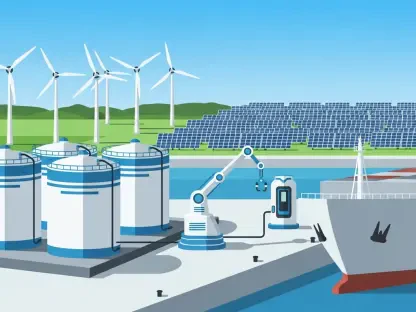The US presidential election has always been a significant event with far-reaching implications, and the oil market is no exception. As the nation heads to the polls, market participants are adopting a “wait and see” approach, reflecting the uncertainty surrounding the election’s outcome and its potential impact on oil futures. This article delves into the various factors at play and how the election could shape the future dynamics of the oil market.
Election Day Market Behavior
Muted Gains and Market Sentiment
On Election Day, oil futures experienced muted gains, with market insiders describing the session as “mundane.” Charlie Macnamara, head of commodities at US Bank, noted a noticeable drop in activity, as most market participants adopted a cautious stance. This “wait and see” approach underscores the uncertainty and anticipation surrounding the election results. The oil market, often sensitive to political developments, seemed to be treading water, with traders waiting for a clearer picture of America’s political future.
The sentiment among investors and traders indicated a collective pause, as the potential turbulence from the election made it challenging to predict short-term movements in oil prices. This cautious approach was evident in trading volumes and market positions, as many chose to stay on the sidelines rather than make bold moves in an unpredictable environment. The muted gains seen on Election Day reflect a broader market sentiment that the election’s outcome, while critical, would not immediately shake the foundations of domestic oil fundamentals.
Insignificance of Immediate Impact
Despite the heightened attention, the election is not expected to have an immediate, substantial impact on domestic oil supply and prices. Market players believe that the election outcome will not directly affect domestic oil fundamentals. Instead, the focus is on the contrasting foreign policy approaches of the candidates and their potential long-term effects on the oil market. The immediate fundamentals of oil supply and demand are shaped by broader forces, making the election’s influence more of a long-term consideration.
Market experts argue that while the election can shift policy directions, the deep-rooted efficiencies and technological advancements in the oil industry have created a more resilient production base. The consensus suggests that any significant changes stemming from the election would unfold gradually, as new policies come into effect and global reactions develop. Thus, while the election holds significant interest for its potential to steer strategic directions, it is the nuanced interplay of various factors that truly defines the trajectory of oil markets.
Domestic Oil Supply and Production Trends
Continued Growth in US Oil Supply
Industry experts agree that US oil supply is likely to continue its growth trend, regardless of the election’s outcome. Current production levels stand at approximately 13.4 million barrels per day, supported by efficiency gains and technological advances. Both candidates, Democratic Vice President Kamala Harris and former Republican President Donald Trump, are viewed as proponents of increased domestic crude output. This bipartisan support for domestic oil production underscores the resilience and strategic importance of the US oil sector.
Economic incentives and advancements in drilling technologies have enabled the US to maintain robust oil production levels, making it a critical player on the global stage. This continued growth is not solely dependent on the political sentiments of the day. Instead, it has solid foundations in the systematic improvements in the sector. Both Harris and Trump have signaled their support for furthering these developments, ensuring that the industry remains on a path of expansion and stability in production capacities.
Historical Support for Fossil Fuels
Insights from Carl Larry, vice president of energy clearing at Marex, highlight that Democratic administrations, such as that of former President Barack Obama, have been more supportive of fossil fuel production than initially expected. This historical context suggests that a Harris administration may not significantly deviate from this trend, further reinforcing the notion of continued growth in domestic oil supply. The pragmatic approach of supporting a vital sector while balancing environmental concerns has characterized previous Democratic policies.
This support is evident in the pragmatic balance between fostering economic growth through energy independence and addressing environmental commitments. The long-term outlook for US oil production thus appears solidly anchored in these dual objectives. Historical trends do suggest that while there may be variances in the extent and methods of support, the core principle of utilizing domestic resources efficiently remains a guiding force for both political factions. This continuity helps anchor industry expectations, allowing them to adapt and thrive irrespective of the shifting political landscape.
Foreign Policy and Its Impact on Oil Markets
Harris’s Lenient Stance Toward Iran
The potential impact of foreign policy on crude markets is underscored as the biggest election-related factor for the oil industry. Harris is anticipated to perpetuate President Joe Biden’s relatively lenient stance toward Iran, which could favor more stable oil supplies. This approach may lead to fewer disruptions in oil supplies and transit through strategic points such as the Strait of Hormuz. A more diplomatic engagement with Iran could potentially open avenues for negotiations and agreement on oil production and sanctions.
Given the strategic significance of the Strait of Hormuz for global oil transit, any policy that reduces tensions in this region is likely to favor smoother and more predictable oil market operations. A Harris administration aligned with Biden’s policies could see a continuation of leveraging diplomatic channels to manage geopolitical risks, thereby reducing the volatility associated with unforeseen supply chain disruptions. Such policies could stabilize global oil markets, creating a more favorable long-term outlook for crude oil prices.
Trump’s Aggressive Rhetoric and Geopolitical Tensions
In contrast, Trump’s campaign rhetoric suggests a much more aggressive stance toward Iran, potentially leading to disruptions in oil supplies and higher oil prices. Conversely, Trump’s anticipated conciliatory actions towards Russia could ease geopolitical tensions, impacting oil prices differently. His well-known propensity for imposing tariffs could also serve as a new headwind for oil prices, affecting international trade and economic relations. This dual approach creates a complex geopolitical landscape, with significant implications for global oil markets.
An aggressive stance towards Iran might lead to heightened tensions and potential conflicts, thereby posing substantial risks to oil supplies from the Middle East. Such scenarios often drive oil prices higher due to anxiety over supply disruptions. Conversely, Trump’s diplomatic overtures towards Russia could lead to a different set of dynamics, potentially easing some geopolitical pressures and introducing a measure of stability. However, the imposition of new tariffs can strain international trade, affecting overall economic health and indirectly impacting oil demand and prices.
Market Reactions and Speculative Positions
Complex Market Reactions
The market reaction to these potential policy directions is complex. Incremental production under Trump, aligned with his “drill, baby, drill” philosophy, suggests a long-term bearish effect on oil prices, albeit not immediately evident. Phil Flynn from Price Futures Group cautions against misconceptions that increased drilling equates to instant price drops, emphasizing that such changes unfold over time. The nuances of policy implementations significantly affect how and when market trends materialize, embedding complexity into market reactions.
Given the intricate relationship between policy shifts and market outcomes, it’s clear that immediate price movements do not always reflect long-term trends. Investors need to consider the lag between policy implementation and its observable effects on production and pricing. While a pro-drilling stance may promise increased supply, the actual adjustments in market prices happen gradually, influenced by various intermediate factors such as infrastructure readiness, regulatory approvals, and technological adaptations.
Adjustments in Speculative Positions
Money managers have adjusted their positions, decreasing net speculative length in West Texas Intermediate (WTI). This move might signal betting on higher supply; however, it could also relate to diminishing geopolitical risks, notably following Israel’s limited actions against Iran. Fawad Razaqzada of StoneX acknowledges the difficulty in pinpointing which factor had the predominant impact, reinforcing the cautious sentiment pervading the market ahead of such a significant risk event. The dynamic nature of speculative market positions reflects broader uncertainties and anticipations regarding future policies and their impacts on oil supplies.
The adjustments in speculative positions highlight the cautious approach many traders are adopting, balancing the potential for increased supply against the backdrop of evolving geopolitical risks. This sentiment underscores the complexity of the factors influencing market behavior, with traders grappling with various scenarios and their potential ramifications. The nuanced interplay between speculative positions and geopolitical developments adds another layer of complexity to predicting market movements, emphasizing the need for a comprehensive understanding of both immediate and long-term influences.
Other Influences on the Oil Market
OPEC-Plus Decisions and Global Conflicts
Besides the election, other critical influences on the oil market include OPEC-plus coalition’s decisions, ongoing conflicts in Ukraine and the Middle East, and macroeconomic factors like fiscal policies and Chinese demand growth. These elements play pivotal roles in shaping the oil market’s future dynamics. OPEC-plus decisions on production quotas and agreements between member countries significantly impact global oil supply levels and price stability.
Moreover, ongoing global conflicts and geopolitical tensions add layers of uncertainty to the oil market, influencing both short-term and long-term market behaviors. These conflicts often result in supply disruptions, leading to price spikes and increased volatility. Macroeconomic factors such as the economic policies of major economies, including fiscal measures and growth projections, directly affect oil demand. For instance, China’s demand growth is a significant driver of global oil consumption, making its economic health a critical factor for the oil markets.
Influence of Federal Reserve Statements
The US presidential election is always a pivotal event with broad consequences, and the oil market is no stranger to this influence. As the nation prepares to vote, market participants are exercising caution, taking a “wait and see” stance due to the uncertainties tied to the election’s outcome and its potential impacts on oil futures. This cautious approach stems from the understanding that shifts in political power can bring significant changes in policies affecting the oil industry, from regulations to trade agreements, and even international relations.
As the election nears, analysts and traders alike are closely monitoring campaign promises and policy proposals from both sides. The outcome can lead to different regulatory environments, taxation policies, and energy strategies, each of which can dramatically alter the supply-demand dynamics of the oil market. Additionally, any prospective changes in environmental policies or international trade agreements can introduce volatility or stability to the market. This article explores these contributing factors and contemplates how the election could reshape the future landscape of the oil market.









